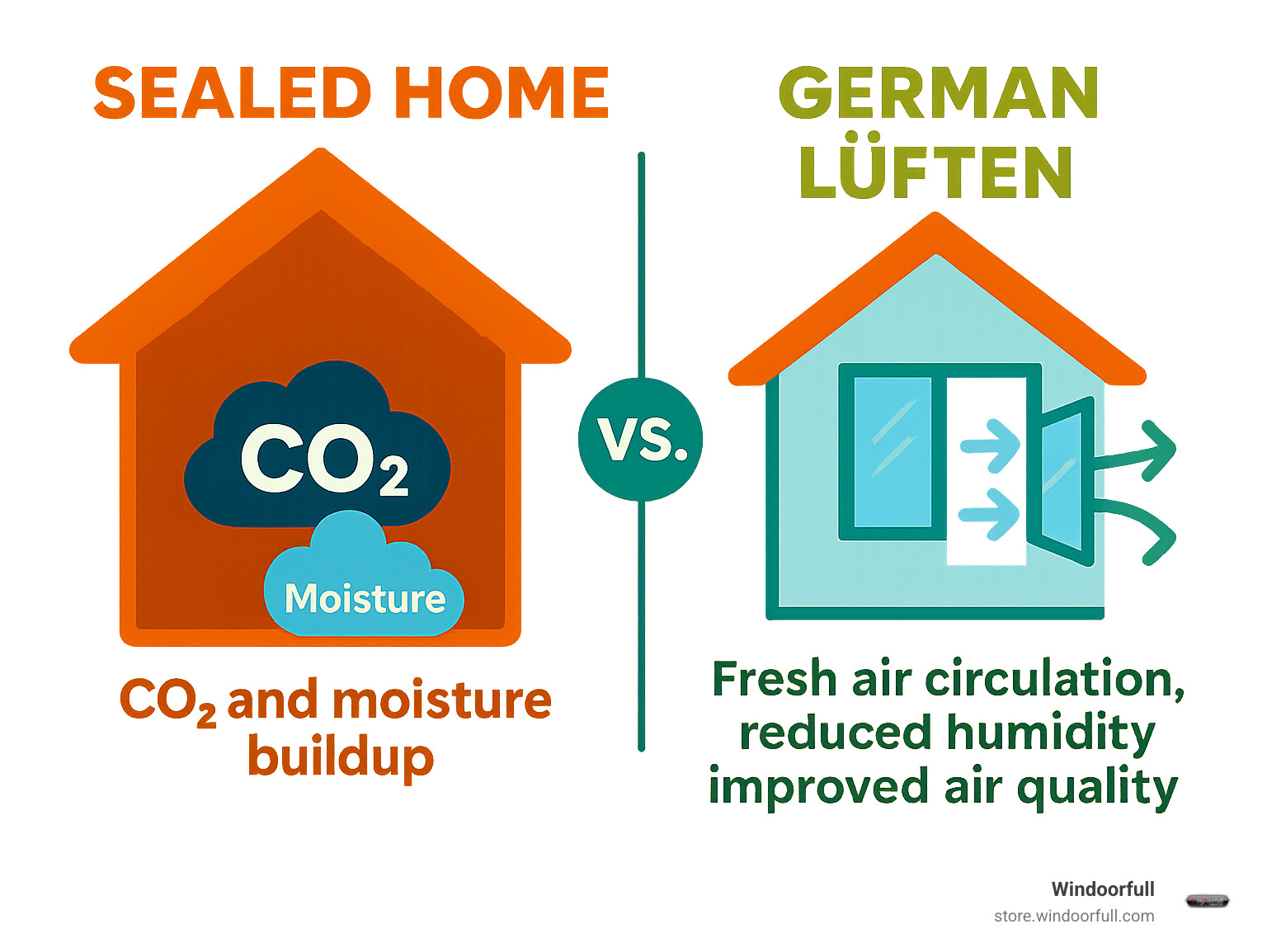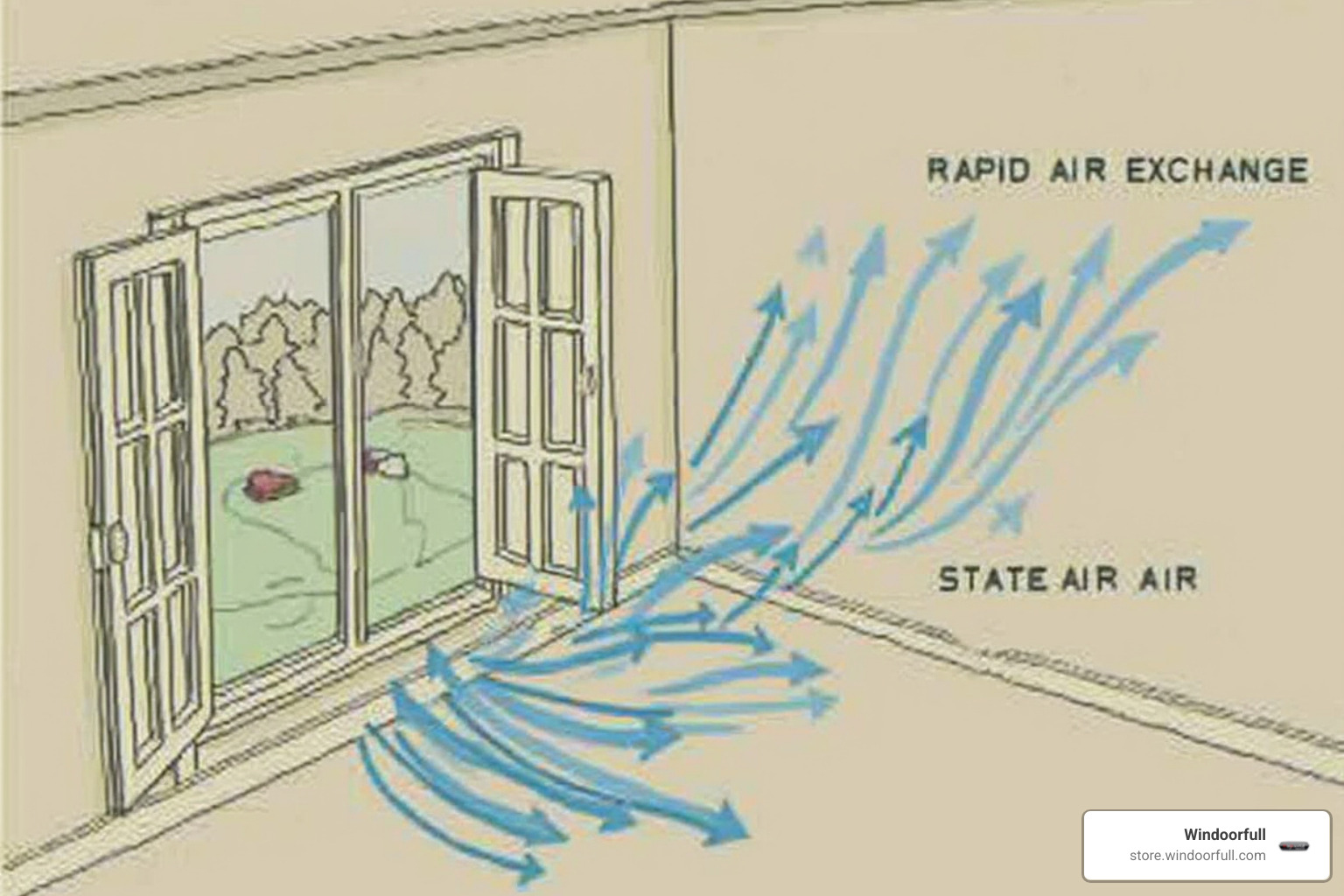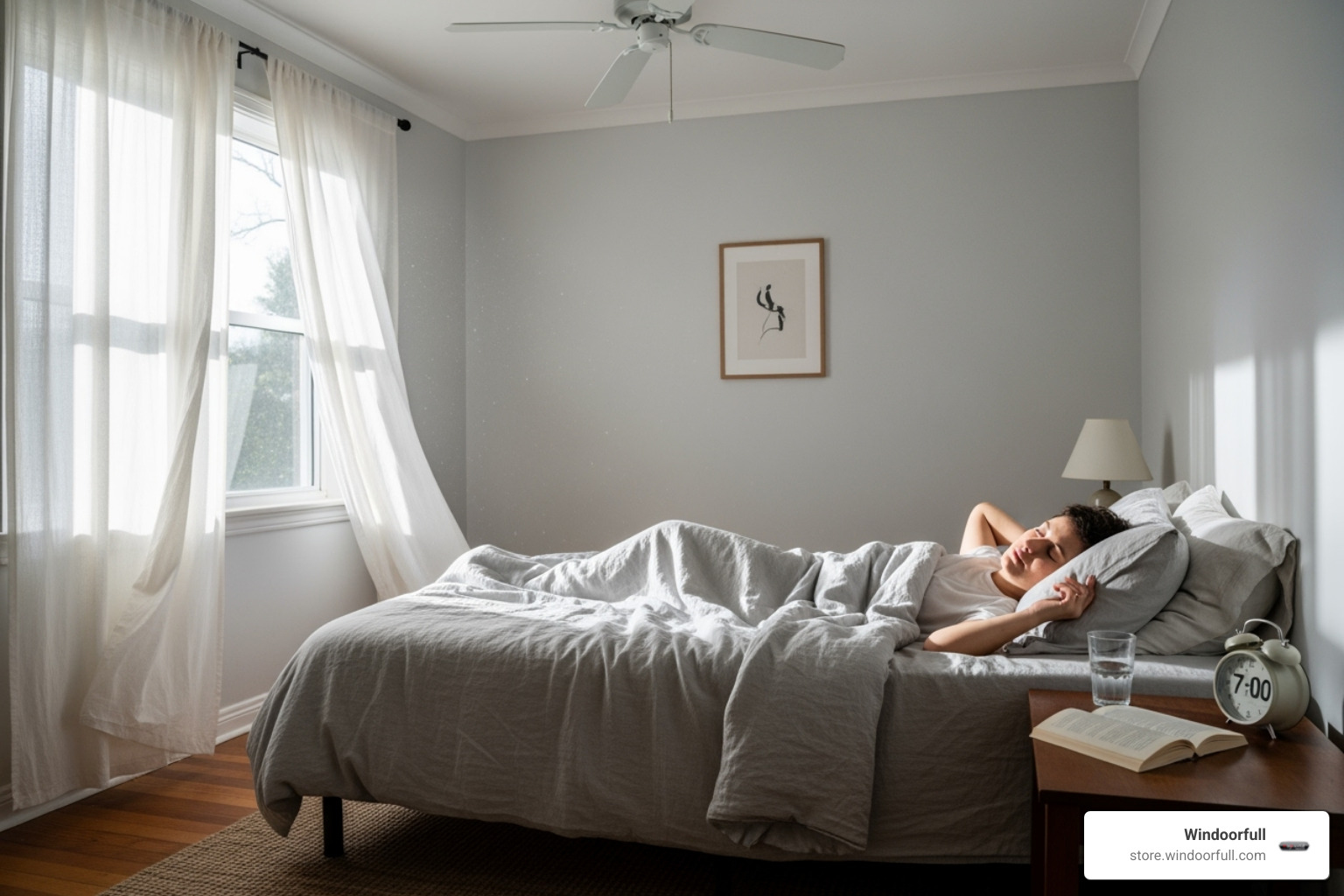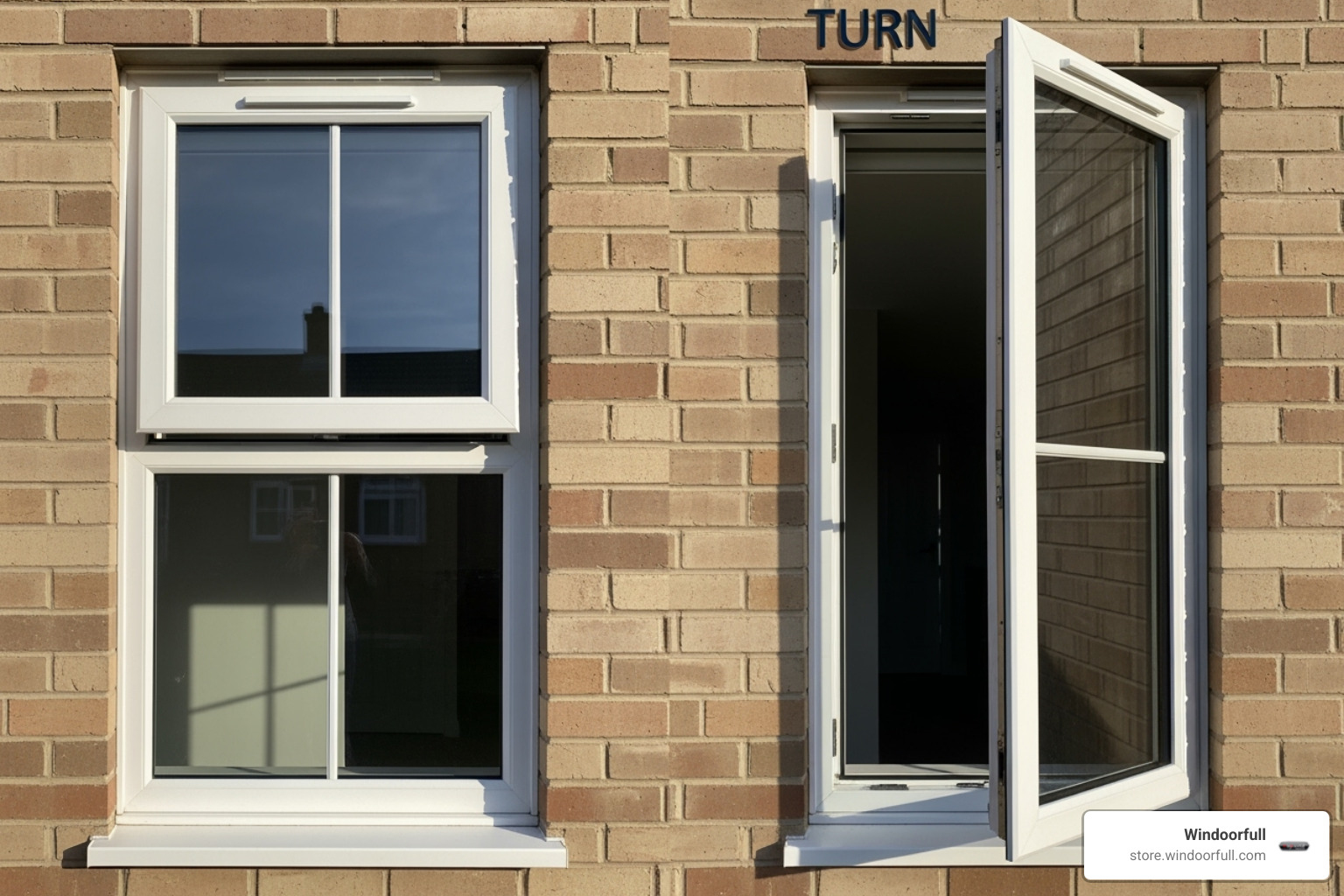
The German Way to Air Out: How to Properly Open Your Windows
Share
Why the German Window Opening Method is Superior to American Ventilation
The german window opening practice, known as lüften, is a time-tested method that exchanges stale indoor air with fresh outdoor air - even during winter. This systematic approach to home ventilation offers several key benefits:
Quick Reference: German Window Opening Techniques
- Stoßlüften (Shock Ventilation): Open windows fully for 5-10 minutes in winter, 10-15 minutes in spring/fall, 20-30 minutes in summer
- Querlüften (Cross-Ventilation): Open windows on opposite sides of the home to create airflow throughout
- Frequency: Practice twice daily - once in the morning and once in the evening
- Benefits: Reduces CO2, eliminates odors, prevents mold, improves sleep quality
While many Americans keep windows sealed tight during cold months, Germans understand that airtight homes trap moisture, carbon dioxide, and pollutants. As one expert notes, "Germans often crack open windows to let nasty, stale air out and fresh, but cold, air in, even in the dead of winter."
The German approach makes perfect sense when you consider their building philosophy: construct homes as airtight as possible to conserve energy, then use strategic ventilation to maintain healthy indoor air quality. This method prevents the buildup of mold, bacteria, allergens, and excess moisture that plague poorly ventilated spaces.
Why This Matters for American Homeowners
Modern American homes face the same challenges as German buildings - they're increasingly airtight for energy efficiency but lack proper ventilation strategies. The result? Poor indoor air quality, musty odors, and potential health issues.
The german window opening method isn't just about cracking a window. It requires specific techniques, timing, and - most importantly - the right window hardware to do it safely and effectively.
We've helped countless American homeowners understand how proper german window opening techniques combined with European tilt-and-turn windows can transform their indoor air quality. My experience importing and installing premium German-engineered windows has shown me why this ventilation approach works so well with the right equipment.

Know your german window opening terms:
What is Lüften? The German Art of Ventilation
Picture this: it's a freezing January morning in Berlin, and your German neighbor throws open their windows wide for ten minutes. You might think they've lost their mind, but they're actually practicing lüften (pronounced 'LOOF-ten') - one of Germany's most sensible daily habits.
Lüften simply means "to ventilate" or "to air out," but it's so much more than just opening a window. It's the conscious, regular practice of exchanging stale indoor air with fresh outdoor air, and it's as routine as brushing your teeth for most Germans.
This isn't some quirky cultural oddity - it's a deeply practical response to modern living. When we breathe, cook, shower, and simply exist in our homes, we're constantly adding moisture and carbon dioxide to the air. In today's well-sealed homes, all that stuff gets trapped inside with nowhere to go.
The german window opening practice tackles this head-on. By strategically ventilating your home, you're preventing mold (Schimmel in German), reducing condensation on windows, and flushing out CO2 buildup that can leave you feeling groggy and tired. It's like giving your house a chance to take a deep breath, which dramatically helps with improving your home's air quality.
What makes this practice so effective is its systematic approach. Germans don't just crack a window and hope for the best - they have specific techniques and timing that maximize air exchange while minimizing energy loss.
Why Germans Prioritize Fresh Air
The German obsession with fresh air makes perfect sense once you understand their building philosophy. German homes are built like fortresses - incredibly airtight and well-insulated to conserve energy. This is fantastic for keeping heating bills low during harsh winters, but it creates a sealed environment where air quality can quickly deteriorate.
Think of it like this: if your home is a thermos bottle (great for temperature control), you need a systematic way to refresh what's inside. That's where lüften comes in.
Germans are also remarkably health-conscious about indoor air quality. They understand that poor ventilation leads to mold growth, increased allergens, and liftd CO2 levels that can affect everything from sleep quality to cognitive function. This isn't just folk wisdom - it's taken so seriously that many German apartment leases actually require tenants to ventilate properly to prevent property damage from moisture buildup.
I've heard stories of German landlords providing detailed, multi-page guides on proper ventilation techniques to new tenants. That's how seriously they take this practice!
The brilliant thing about the German approach is that it combines energy efficiency with health consciousness. Instead of leaving windows cracked open all day (which wastes energy), they use short, intense ventilation sessions that completely refresh the air without losing much heat. It's a perfect example of bringing the outdoors into your home in the most efficient way possible.
This systematic approach to fresh air isn't just about comfort - it's about creating a healthier living environment that supports better sleep, clearer thinking, and overall well-being.
Mastering Lüften: Key Techniques for Fresh Air
Learning the german window opening method is like finding a secret to better indoor air quality. It's not just about cracking a window whenever you feel like it – there's actually a science to doing it right. The Germans have perfected two main techniques that work beautifully together, and once you understand them, you'll wonder why you never ventilated your home this way before.

The two core techniques are Stoßlüften (shock ventilation) and Querlüften (cross-ventilation). Think of them as your ventilation toolkit – one for quick, efficient air exchanges and another for whole-home freshening. Getting the timing right and following a few practical safety tips will make all the difference in your results.
Stoßlüften (Shock Ventilation): The Quick Refresh
Stoßlüften (pronounced 'SHTO-ss-loof-ten') is the star of winter ventilation. It's brilliant in its simplicity: throw your windows wide open for just a few minutes to completely refresh your indoor air without losing the warmth stored in your walls and furniture.
Here's why it works so well. When you open windows fully for a short burst, you're rapidly exchanging stale, humid air with fresh outdoor air. The cold air rushes in, but your walls, floors, and furniture – which hold most of your home's heat – stay warm. As researcher Raymond Galvin from the University of Aachen and Cambridge puts it: "You open your windows completely for three minutes if it's windy, five to 10 minutes if it's not."
The magic happens because air itself holds very little thermal energy compared to the solid structures in your home. Once you close the windows, that fresh air warms up quickly from the heat radiating from your walls and furniture. You get completely fresh air without the energy penalty of leaving windows cracked for hours.
Make shock ventilation part of your daily routine – once in the morning to clear out overnight stuffiness and once in the evening before bed. Your lungs (and your heating bill) will thank you.
The timing changes with the seasons:
- Winter: 5-10 minutes twice daily (just 3 minutes if it's windy outside)
- Spring and Fall: 10-15 minutes twice daily
- Summer: 20-30 minutes twice daily (you can also leave windows open longer when weather permits)
The key is opening windows fully – not just tilting them slightly. A tiny crack might seem gentler, but it's far less effective and actually wastes more energy over time.
Querlüften (Cross-Ventilation): The Whole-Home Flush
While Stoßlüften refreshes individual rooms, Querlüften (pronounced 'KVEER-loof-ten') creates a powerful airflow that flushes your entire home. This technique turns your house into a natural wind tunnel by opening windows on opposite sides of your living space.
The effect is remarkable. Fresh air rushes in one side while stale air gets pushed out the other, creating a complete air change throughout your home. It's perfect for milder weather when you want that deep-clean feeling for your indoor air.
Querlüften works especially well for eliminating cooking odors, reducing humidity after showers, or just giving your home that crisp, fresh feeling. As one expert notes, it's a simple and free way to make your home smell better naturally.
When you're creating this cross-ventilation, turn off your heating or cooling system first. Otherwise, you're just fighting against your HVAC system and wasting energy. The goal is a complete, intentional air exchange.
Don't worry if your rooms don't have perfectly opposing windows. You can still achieve great results by opening a window and the room door, letting air flow into hallways or other areas where cross-ventilation is happening. The key is creating that pathway for air to move through your space rather than just swirling around in one room.
The Science Behind the German Window Opening Practice
The german window opening method isn't just a quirky cultural habit - there's real science backing why Germans are so passionate about lüften. When you dig into the research on indoor air quality, health benefits, and energy efficiency, you'll find this practice makes a lot more sense than you might initially think.

Health, Air Quality, and Better Sleep
Your home is constantly collecting invisible pollutants. Volatile organic compounds from furniture and cleaning products float through the air. Dust mites, pet dander, and other allergens settle into every corner. Meanwhile, every breath you take adds carbon dioxide to the mix.
Without proper ventilation, these pollutants just keep building up. The result? You might experience headaches, feel tired for no reason, or notice your allergies acting up more at home than outside.
The german window opening practice tackles this head-on by flushing out contaminated air and replacing it with fresh, oxygen-rich outdoor air. This simple exchange can dramatically reduce allergens and lower CO2 levels throughout your home.
But here's where it gets really interesting - lüften can actually help you sleep better. Most sleep experts recommend keeping your bedroom between 65 and 67 degrees Fahrenheit for optimal rest. This cooler temperature works with your body's natural temperature drop during sleep, helping regulate your circadian rhythm.
A fascinating study by Chenxi Liao found some compelling evidence for improved sleep quality with open windows. People who slept with windows open snored less and woke up fewer times during the night. Dr. Valerie Cacho explains that proper ventilation creates fresh air conditions that are naturally conducive to better sleep.
Energy Efficiency and Common Criticisms
Now let's address the big question: "Isn't opening windows in winter just throwing money out the door?" It's a fair concern, especially when we're all trying to reduce energy costs and environmental impact.
Here's the thing - when done correctly, Stoßlüften is surprisingly energy-smart. German homes are built as airtight fortresses with incredible insulation. This means when windows are closed, virtually no heat escapes.
The secret lies in understanding where your home's heat actually lives. About 90% of thermal energy is stored in your walls, floors, and furniture - not floating around in the air. When you practice proper german window opening techniques, you're only exchanging the air while all those solid structures retain their warmth.
Think of it this way: heating fresh, dry air takes much less energy than you'd expect. Plus, humid air requires more energy to heat than dry air, so removing moisture through lüften can actually make your heating system work more efficiently.
But here's where things get tricky. Some research suggests that Germany's devotion to lüften might be undermining energy efficiency goals. The problem isn't the technique itself - it's how people actually use it.
Many Germans claim they practice proper Stoßlüften but actually leave windows tilted open for hours. This approach is terribly inefficient because it allows continuous heat loss without effective air exchange. One researcher noted, "Although most Germans swear that they only practice Stoßlüften, my research has found that hardly anyone actually does."
This highlights why having the right windows matters so much. Tilt and turn windows make it easy to choose between quick, effective Stoßlüften (full open position) and longer-term gentle ventilation (tilt position) - but only when used correctly for each situation.
The Engineering Advantage: How German Windows Facilitate Lüften
The magic of the german window opening method isn't just about technique – it's about having the right tools for the job. German windows, particularly the ingenious tilt and turn design, are specifically engineered to make lüften safe, secure, and incredibly effective.

These aren't your typical American windows. Tilt and turn windows dominate the European market for good reason – they're a masterpiece of precision engineering that perfectly supports the German philosophy of efficient ventilation. Through our work at Windoorfull Imports, we've seen how these windows transform the way Americans think about home ventilation. They truly represent the gold standard for modern homes, bringing authentic European innovation to American households. You can explore more about these remarkable windows in our comprehensive guide, Euro Windows Unveiled.
The Ingenious Design of the German Window Opening
What makes these windows so special? It all comes down to one simple handle that controls three distinct positions. The first tilt and turn hardware was developed in Germany back in the 1950s – a testament to German engineering prowess that's still best today.
Here's how this brilliant system works: When you turn the handle downward, the window locks securely with multiple locking points around the entire frame. This creates an airtight seal that would make a submarine jealous – no drafts, no energy loss, just perfect insulation.
Turn that same handle upward, and you activate the tilt function. The top of the window tips inward, creating what Germans call "auf Kippe" position. This gives you secure, continuous ventilation even when you're sleeping or away from home. It's perfect for letting out shower steam or providing gentle overnight airflow, and you can even ventilate during light rain without flooding your floors.
Turn the handle horizontally, and the entire window swings inward like a door. This turn function opens up maximum airflow – ideal for those quick Stoßlüften sessions or creating cross-ventilation throughout your home. Plus, since the window opens inward, cleaning the outside glass becomes a breeze. No more dangerous ladder climbing or awkward reaching – you can safely clean both sides from inside your home.
For a deeper dive into this remarkable mechanism, check out our detailed guide: Beyond the Hinge: Everything You Need to Know About Tilt-Turn Windows.
Why Tilt and Turn Windows are Perfect for the German Window Opening
After years of helping American homeowners upgrade to European-style windows, we've learned exactly why tilt and turn windows are the perfect partner for german window opening techniques.
The tilt position solves one of the biggest problems with traditional American windows: security during ventilation. You can leave your windows tilted for hours – even overnight or while you're at work – without worrying about break-ins. The window remains securely latched while providing steady airflow. Try doing that with a typical double-hung window!
For rapid air exchange during Stoßlüften, the turn position can't be beat. The full inward swing creates maximum airflow for the quickest possible air turnover. This efficiency is crucial for removing stale air and humidity without wasting energy.
When closed, our uPVC tilt and turn windows create a completely airtight seal. We're talking zero drafts – a stark contrast to many American windows that let cold air sneak through even when "closed." This superior sealing means your heating and cooling systems work more efficiently, and you stay comfortable year-round.
The tilt position also provides excellent weather protection. Light rain, strong winds, or even snow won't prevent you from ventilating your home. The angled opening naturally deflects moisture while maintaining airflow.
Here's how tilt and turn windows stack up against typical American double-hung windows:
| Feature | Tilt and Turn Windows | American Double-Hung Windows |
|---|---|---|
| Ventilation |
Tilt: Secure, continuous airflow with rain protection Turn: Complete, rapid air exchange |
Partial: Limited airflow with security risks Full: Maximum airflow but vulnerable to weather and intruders |
| Security | Multi-point locking system keeps window latched even when tilted | Single or double latches; vulnerable when open for ventilation |
| Cleaning | Easy exterior cleaning from inside due to inward swing | Often requires ladders or dangerous reaching for exterior cleaning |
This comparison makes it clear why the german window opening approach works so beautifully with proper European hardware. It's not just about the technique – it's about having windows designed specifically to make healthy ventilation safe, secure, and effortless.
Frequently Asked Questions about Lüften
As someone who's helped hundreds of homeowners understand the german window opening method, I get asked about lüften constantly. Whether you're just finding this practice or trying to perfect your technique, these are the questions that come up most often.
How often should I air out my house?
The golden rule for lüften is twice a day minimum - once when you wake up and once before bed. Think of it like brushing your teeth; it's just part of a healthy daily routine.
Your morning session clears out all the CO2 and moisture that built up overnight from breathing. Your evening session refreshes the air before you settle in, helping you sleep better. But don't stop there if your home needs it.
You'll want to add extra ventilation sessions after activities that pump moisture and odors into your air. After cooking a big meal, after long hot showers, or after drying clothes indoors, give your home a quick Stoßlüften session. If you notice any stuffiness or musty smells creeping in, that's your home telling you it needs fresh air.
The beauty of this practice is that even a short 5-10 minute burst makes a huge difference. Consistency beats perfection every time.
Is it okay to lüften when it's raining or very humid?
This question always makes me smile because it seems so backwards at first. Yes, you should absolutely practice lüften when it's raining or humid outside!
Here's the thing most people don't realize: your indoor air is almost always more humid than outdoor air, especially in an airtight home. When you're breathing, cooking, showering, and just living, you're constantly adding moisture to your indoor environment.
When it's raining, the tilt function on German windows is perfect. You get continuous fresh air without letting rain into your home. For quick Stoßlüften sessions, even light rain won't cause problems because you're only opening windows for a few minutes.
The humidity issue is even more interesting. Cold air holds much less moisture than warm air, so even if it feels humid outside, that outdoor air becomes relatively dry when it warms up inside your home. You're trading your super-humid indoor air for fresher air that will actually help reduce your overall indoor moisture levels. This is exactly how you prevent mold and condensation problems.
Can I practice lüften if I have seasonal allergies?
Absolutely, but you'll want to be smart about timing. I understand the concern - nobody wants to invite pollen into their home just to get fresh air.
The key is ventilating when pollen counts are naturally lower. Early morning hours, late evening, and right after rain are your best friends. Rain literally washes pollen out of the air, making it one of the best times for allergy sufferers to open their windows.
Avoid the peak pollen hours, which are typically mid-morning through late afternoon on dry, windy days. Many weather apps now include pollen forecasts, so you can plan your lüften sessions around low pollen times.
Here's a practical tip from our experience at Windoorfull: consider adding window screens. While traditional German windows don't come with built-in screens like American windows, you can absolutely add them. Screens filter out larger particles like pollen and insects while still allowing excellent air exchange. It's a simple upgrade that lets you practice lüften with much more confidence, even during allergy season.
The goal is finding the balance between fresh air benefits and managing your allergy triggers. With the right timing and perhaps some screens, you can enjoy both.
Conclusion: Accept the Fresh Air Lifestyle
The german window opening method isn't just some old European tradition that sounds nice in theory. It's a practical, science-backed approach to creating a healthier home that actually works - and works well.
Think about it: we've covered how lüften prevents mold, flushes out indoor pollutants, and can even help you sleep better at night. These aren't small benefits. They're the kind of improvements that make a real difference in how you feel every single day.
The beauty of this practice lies in its simplicity. Stoßlüften takes just 5-10 minutes in winter, while Querlüften gives your whole home a fresh air flush when the weather's right. No expensive equipment, no complicated systems - just strategic window opening that works with your home's natural airflow.
But here's the thing: having the right windows makes all the difference. Those German tilt and turn windows we've talked about? They're not just convenient - they're what make the german window opening method truly safe and effective. The tilt function lets you ventilate securely while you're away or sleeping. The turn function gives you that rapid air exchange for perfect Stoßlüften.
At Windoorfull, we've seen how the right windows transform this practice from challenging to effortless. Our European-engineered uPVC tilt and turn windows bring authentic German functionality to American homes at prices that actually make sense. We import the real deal - not some watered-down version - because we believe every home deserves superior air quality and the versatility that comes with proper engineering.
The fresh air lifestyle isn't about making your life more complicated. It's about making it healthier, more comfortable, and surprisingly more energy-efficient when done right. Your lungs will thank you, your sleep will improve, and your home will feel genuinely fresher.
Ready to experience what proper ventilation feels like? Find why tilt and turn windows are The Smart Choice for Modern Homes: Why Tilt and Turn Windows Belong in Your USA Home. Local pickup is available in Ozone Park, New York.
Your home - and your health - deserve nothing less than the best.
